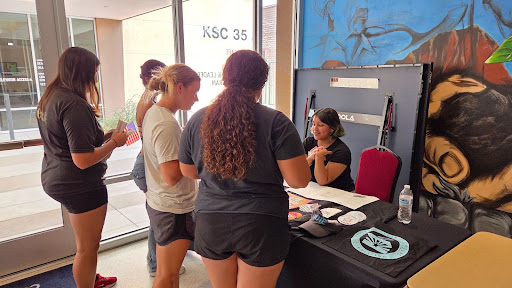Owl spotted on the MCC Southern and Dobson Campus
David Westlake
Mesa Legend

Mesa Community College (MCC) can no longer claim to be a “habitat” just for students. Earlier this semester an owl was sighted on campus near the Paul A. Elsner Library. The owl was seen lingering for several days before it disappeared. Some students wondered if the bird was removed or if it flew away. Other commented on how unusual it was to see an owl on campus.According to wildlife experts, animals like owls, birds, rattlesnakes, leopard frogs, and depending on locations, even jaguars have been attracted to land masses like community college campuses because of the landscape which allows for finding a place for protection.
Randy Babb is with the Arizona Game and Fish Department (AZGFD) in Mesa. He said the burrowing owl is the most common owl seen in these parts. They’re small birds with long legs that dig holes to shelter themselves from areas with low vegetation. “Burrowing owls do some migration. So you might’ve come across a migrant coming through, stopping for a few days to use those culverts,” Babb said. “What they really like is irrigation ditch banks, where there is a lot of deep soil,” he added.
The burrowing owl migrates to Arizona around early fall and looks to create nests in various hidden locations. Babb says MCC is just a pit stop for the bird. “Mesa Community College is no longer a good habitat anymore. It’s too urbanized around it,” he said.David L. Pearson, an ecology professor at Arizona State University School of Life Sciences agrees. “They are all around us, but they’re being pushed back more into the desert,” he said.
Pearson explains that as open landscapes are developed the more the owls are forced to look for a place to stay, at times within urbanized areas with some open space. “Safe nesting areas are made to be protected by predators such as pets, and they have a field to hunt at night when it’s cooler to eat a lot of insects,” Pearson added. According to a report at the University of Arizona with the Department of Defense (DOD) and the United State Geological Survey, burrowing owls once migrated as far north into western Canada. But over the decades the bird has become less migratory and a year-round species in the Southwest, often seen in DOD bases.
This is such a concern that burrowing owls are listed as federally endangered in Canada. The United States Fish and Wildlife Service has it listed as a species of national conservation concern. States like Minnesota and Iowa list the burrowing owl as endangered, with California and Washington already petitioning for the same status. More alarming, Arizona along with six other states have reported a burrowing owl population decline. There are colleges who welcome and make sure the species is protected and preserved. Scottsdale Community College (SCC) is among those campuses providing a home for the burrowing owl.
“They have these big black tubes from previous housing sites that attract the owls and keeps the burrows from collapsing,” explained AZGFD expert Babb. The tubes are located near SCC Center for Native and Urban Wildlife. It’s been a home for burrowing owls for more than 40 years. Both experts agree that when you come across an untamed animal, and it doesn’t cause any danger to anyone, stay away. “Let wildlife be wildlife,” Babb said.









